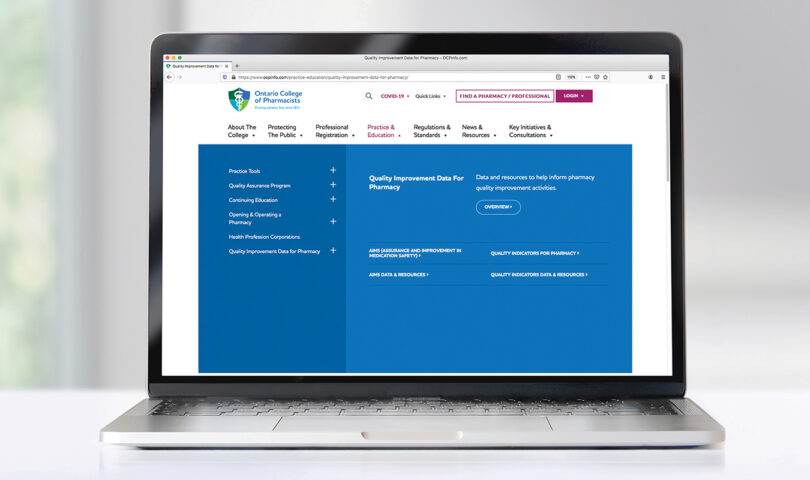Quality improvement among pharmacy professionals and their teams provides an opportunity to focus on areas that can enhance the way care is delivered to patients. Having access to relevant data can help address those areas and help to inform continuous quality improvement initiatives that can have a positive impact on patient safety and health outcomes.
Successful quality improvement initiatives are data-driven, and registrants and patients need the tools and information to make informed decisions.
One of the keys to improving patient safety and health outcomes is to identify opportunities to share data that are accurate and meaningful and have the necessary context for registrants to be able to make quality improvements in their practice. This is an important part of the College’s commitment to accountability and transparency, and to fulfilling our mandate of serving and protecting the public.
The College publicly shares data from a number of sources that allows pharmacy professionals to assess their practice against regional and provincial data, giving them the necessary information to build continuous quality improvement plans that enhance both patient safety and health outcomes.
MANDATORY AIMS (ASSURANCE AND IMPROVEMENT IN MEDICATION SAFETY) PROGRAM
The AIMS (Assurance and Improvement in Medication Safety) Program is a standardized medication safety program that supports continuous quality improvement and puts in place a mandatory consistent standard for medication safety for all community pharmacies in the province. Its goal: to improve medication safety and reduce harm caused by medication incidents.
The AIMS Program enables practitioners to learn from medication incidents, and better understand why they happen and how they can be prevented. Utilizing both a preventative approach through proactive reviews of work processes to identify areas of risk and retrospective reviews of specific medication incidents, pharmacy professionals will be able to identify learnings that will help prevent incidents and near misses and enhance patient safety.
Using AIMS data
The College is evolving new ways to provide registrants with practice insights based on AIMS data. Registrants are encouraged to use the data warehouse within the AIMS Pharmapod platform to review their own pharmacy data and to compare it to provincial results, as well as to use the continuous quality improvement tool as part of their own quality and medication safety improvement plans.
An interactive tool on the College website also provides the ability to view aggregate, anonymous medication incident and near miss data on some of the event recording fields available through the AIMS Program.
QUALITY INDICATORS
To better understand the impact of pharmacy care on patient outcomes, the College, in partnership with Health Quality Ontario (now called Ontario Health), established the first set of Quality Indicators for community pharmacy in Canada. These indicators provide the public with a clearer picture of the overall quality of pharmacy care in Ontario and support quality improvement efforts by pharmacy teams and the College.
An interactive tool that reports data from the first three Quality Indicators on appropriateness of dispensed medications, medication-related hospital visits, and transitions of care is now available on the College website.
Registrants are encouraged to use the tool alongside information and data from their own practice to better understand the quality of care they provide. While the data does not provide information about any one pharmacy, the tool helps identify regional and provincial trends that can help registrants and teams focus their efforts when developing continuous quality improvement initiatives in their own practice.
Patient/Caregiver-Reported Experience Measures
The Patient/Caregiver-Reported Experience Measures were developed for community pharmacy in 2019 using a rigorous process led by an expert panel that incorporated feedback from more than 100 patients, 20 corporate executive leaders and 100 frontline pharmacy professionals. To confirm these indicators measure areas of pharmacy care that are important and relevant to patients and caregivers they will be validated before a plan for data collection is developed.
Once the indicators have been validated, the College will undergo user testing and work alongside experts in collecting information from patients and those who own, operate and practice within community pharmacy to develop a data collection plan.
Provider Experience Measures
Measuring the experience of pharmacy professionals is an important part of the Quality Indicators for Pharmacy initiative, and developing these provider experience measures requires broad engagement with registrants. The start of this process was postponed from Spring 2020 in recognition of the pressures experienced in community pharmacy due to the COVID-19 pandemic response. The College continues to monitor the impact of this pandemic on community pharmacy to determine when the process of developing provider experience measures can move forward. At this time, the plan is to launch a working group by the Fall.













